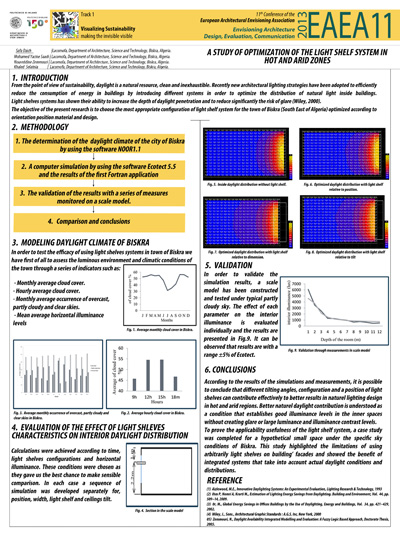11th EAEA Envisioning Architecture: Design, Evaluation, Communication Conference in 2013
Track 1 | Visualizing Sustainability - Making the invisible visible
A study of optimization of the light shelf system in hot and arid zones
Keywords: natural light; simulation (Ecotect, Radiance); light shelf system
ABSTRACT
From the point of view of sustainability, daylight is a natural resource, clean and inexhaustible. For this, it has become a key element in the architectural design phase especially in the sketch that the architect should be used wisely and appropriately to ensure visual comfort, increase productivity factor space , significantly improve aesthetics and reduce energy consumption to conserve the planet environment and the durability of the natural resources. Buildings seem to consume large amount of electricity for lighting and thus producing tones of CO2. The sustainable architecture adopt new strategies in natural lighting, by introducing new ecological systems and sustainable technology for the optimization of the distribution of natural light inside buildings, consists in reducing the electricity consumption. One of the smartest technology is what we call "light shelf system". It is reflector installed at the level of the window which is used mostly to increase the level of illumination in spaces with large depths. In addition it helps reduce the glare effect which occurs under great illuminance levels and also the overheating during summer period.
The objective of this research is to choose the most appropriate configuration of light shelf system and test without efficacity in hot and arid zones (the climate of the city of Biskra, Algéria) in order to bring the natural light in the deep space and ensure both a uniform illumination, ambient light and cover needs shading of this space. The determination of this configuration requires knowledge of light climate of the city. This town is characterized by very large amount of illuminance wich is not exploied and led to the use of fossil energy to provide lighting of the buildings and especially profound spaces. To achieve these objectives, we propose a computer simulation by using the software Ecotect 5.5, RADIANCE, NOOR1.1 and an experiment using a scale model. This experience will lead us to make a quantitative and qualitative evaluation of the light environment of an architectural space equipped with a light shelf system under specific climatic conditions for the city of Biskra. The results of this study have shown that the installation of the light shelf under climatic and environmental conditions of the city of Biskra can both illuminate naturally deep, have a good distribution of light throughout the room and a daylight factor of moderate , different lighting scenes, to shade the window from direct sunlight to reduce the risk of glare, to prevent penetration of the sunspot especially in summer, to reduce the use of electric lighting during the day and therefore, keep the occupants in a situation of visual and thermal comfort. We conclude that the system is light shelf element of sustainable design architecture.
AUTHORS
Safa Daich
Lacomofa, Department of Architecture, Science and Technology, Biskra, Algeria
Med Yacine Saadi
Lacomofa, Department of Architecture, Science and Technology, Biskra, Algeria
Noureddine Zemmouri
Lacomofa, Department of Architecture, Science and Technology, Biskra, Algeria
Khaled Selatnia
Lacomofa, Department of Architecture, Science and Technology, Biskra, Algeria
